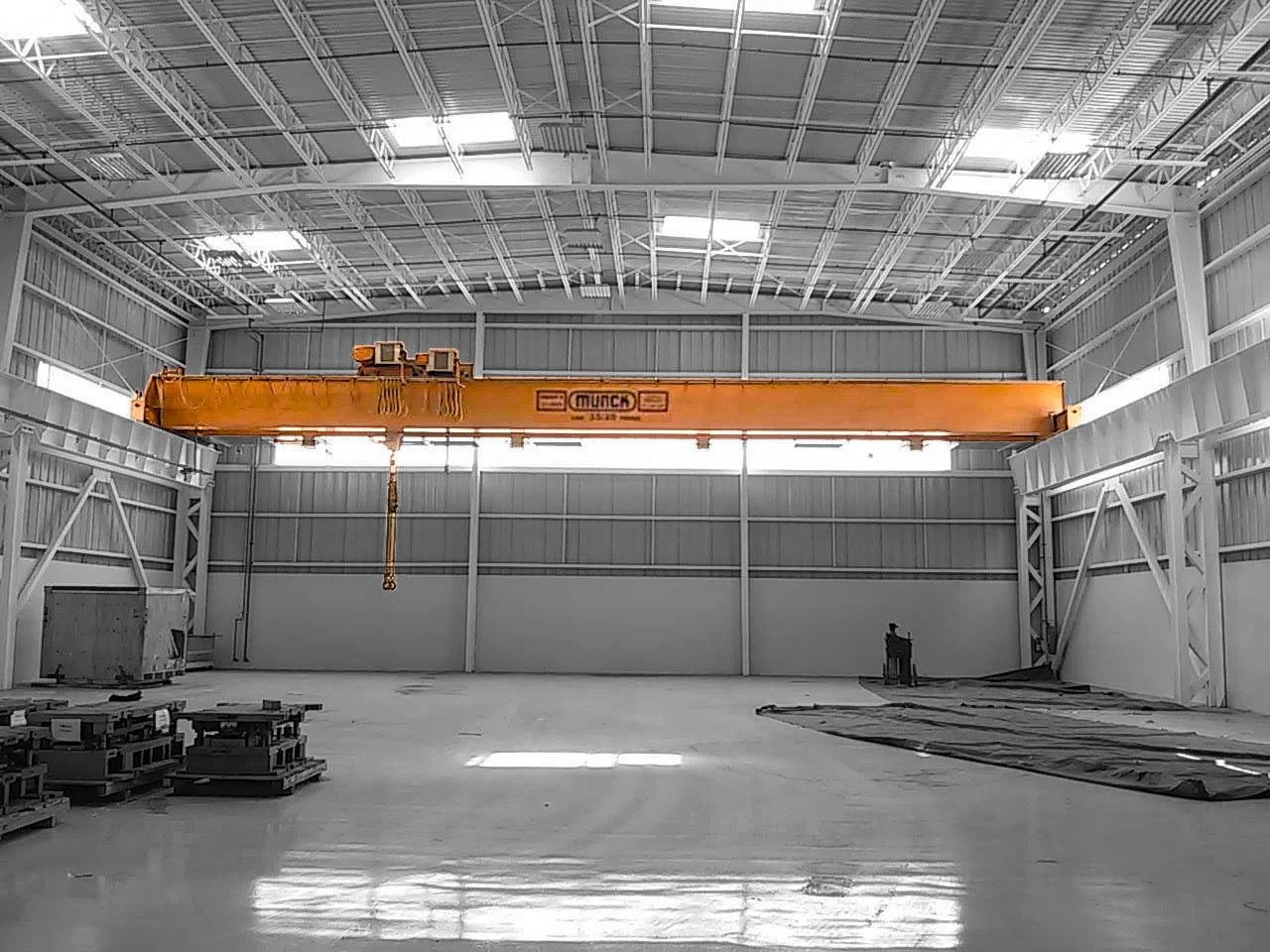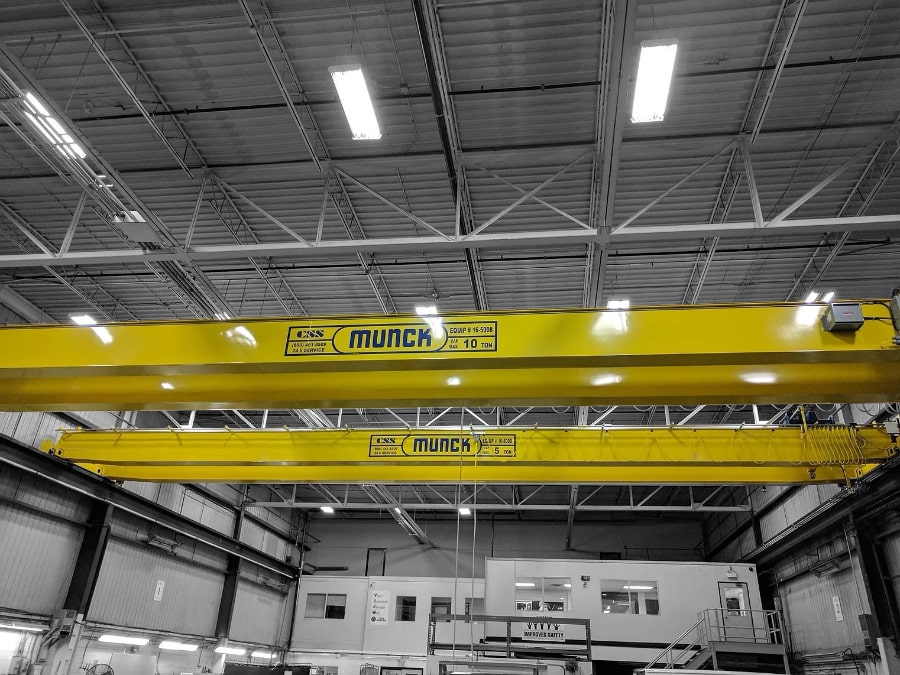 This article explains the key differences between top-running and under-running overhead cranes and will help you decide the best fit for your plant’s layout, capacity and workflow.
This article explains the key differences between top-running and under-running overhead cranes and will help you decide the best fit for your plant’s layout, capacity and workflow.
Which Crane is the Better Fit
When designing or upgrading an overhead lifting system, one of the first differences you’ll run into is whether a top-running or under-running crane is the better fit.
Both crane types are classified as overhead cranes and while they share similar functions of moving loads along a runway system, they operate in very different ways and are suited for different environments.
Continue reading for a breakdown of what separates the two and which factors should guide your choice.
Top-Running Cranes Have Strength and Span
Top-running cranes ride on rails that are mounted to the top of the runway beams. This design gives them a number of structural and operational advantages.
Features of Top-Running Cranes
- Higher load capacities and typically used in heavy-duty applications. They can handle larger spans and heavier loads.
- Greater hook height since the hoist sits on top of the beam where you get more vertical lift.
- Larger spans are ideal for wide buildings or applications where maximum coverage is needed.
Where You’ll Find Them
You’ll find top-running cranes in facilities that deal with bulk-lifting like steel plants, shipyards and large warehouses where they rely on top-running cranes for day-to-day movement of heavy materials.
If your operation is moving toward bridge cranes, gantry cranes, or workstation cranes and if your loads are substantial, a top-runner might be the next logical investment for your plant.
Under-Running Cranes are Spacious and Flexible
Under-running cranes (also called underhung cranes) are supported by the building’s roof structure or on a freestanding runway system. Instead of riding on top of the beams they hang below them.
Features of Under-Running Cranes
- Better for lighter loads and great for workstations, maintenance shops and areas where material handling is frequent but not heavy.
- Tighter hook approaches means the hoist can get closer to the end of the runway and make it more efficient in confined areas.
- Eliminates need for columns and hangs directly from the existing roof structure, saving floor space.
When They Make Sense
An under-running crane is ideal when the building support structure is strong and loads are under 10 tons. If your main focus is on improving workflow in the production line or warehouse without major construction, an underhung system can provide exactly what you plants needs.
Comparison Table of Top-Running vs Under-Running Cranes
The following table covers load capacity, support structure, hook height, floor space impact, span capability and crane installation cost.
| Feature | Top-Running | Under-Running |
| Load Capacity | Up to 100+ tons | Generally up to 20 tons |
| Support Structure | Requires columns/runway beams | Generally suspended runway system |
| Hook Height | Varies on runway suspension height | Varies on runway suspension height |
| Floor Space Impact | Requires columns if freestanding | Minimal impact when roof-supported |
| Span Capability | Wide spans possible | Narrower span range |
| Installation Cost | Higher (due to structure needs) | Economical (depending on supports) |
You can print this PDF table for future reference as to each crane type’s feature.
Factors to Consider When Choosing
Download the Top-Running vs Under-Running Crane Selection Chart (PDF) and share with maintenance, production, and purchasing to help your decision team better understand which crane applies to your current needs.
Load Weight and Volume
 If you’re lifting extremely heavy loads on a regular basis, top-running systems are built for that. Under-running systems cap out more quickly and may require multiple units to do the same job.
If you’re lifting extremely heavy loads on a regular basis, top-running systems are built for that. Under-running systems cap out more quickly and may require multiple units to do the same job.
Building Structure
Not all facilities can handle the load that under-running cranes apply to the roof. Likewise, not every floor layout is ideal for installing the columns needed for a top-running crane.
Hook Coverage and Clearance
Top-running cranes are particularly useful in tight layouts because it gives you more lift and reach while under-running systems let you work closer to building walls or runways.
If you want a quick reference you can bring to a planning meeting, print the Top-Running vs Under-Running Crane Selection chart (PDF) to match typical plant situations to the right crane type and narrow the discussion before you call us.
Choosing What Fits Your Operation
Use the information above during your facility planning phase. If you’re unsure what crane suits your environment, you can read this article on how overhead cranes optimize operations to help you visualize their impact on workflow. You can also contact Munck Cranes for a complimentary question-and-answer call about your plant needs.
General factors:
- Use a top-running crane when capacity, lift height and span are top priorities.
- Choose an under-running crane when building structure and space flexibility outweigh raw lifting power.
Your hoist setup is also a factor
Another consideration is your hoist setup. If you’re comparing options, this overview of electric wire rope vs. electric chain hoists explains how each hoist interacts with different crane types.
And if you’re still unsure as to what crane build you really need (bridge, gantry, jib, or workstation), our guide on choosing the right crane system walks you through the strengths and limitations of each.
If you’re ready to take the next step toward modernizing or expanding your material handling systems, crane specialist is ready to discuss what’s possible within your facility.